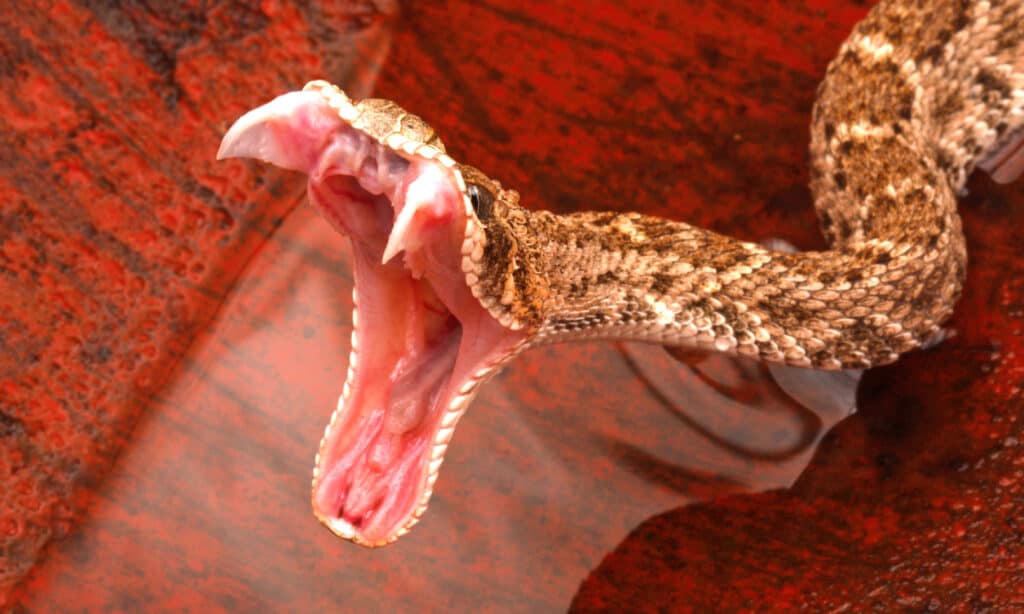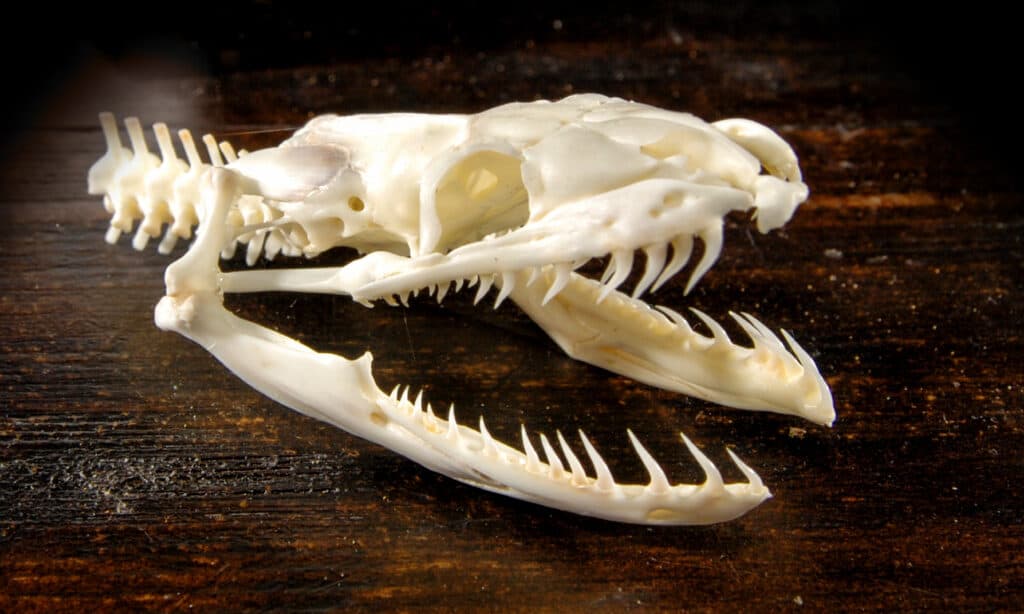Burmese pythons are an extremely famous – or infamous snake species. They are most popular in Florida for gradually but causing significant damage to the Everglades. However, there’s more to this unique species, especially when they are considered in their native Southern and Southeast Asian habitats.
These large pythons are non-venomous constrictors, which means that they do not have fangs, but they do have multiple rows of teeth. In this article, we will uncover everything you need to know about the Burmese python teeth.
Fangs Vs. Teeth

Fangs are venom-injecting teeth found on venomous snakes.
©iStock.com/johnaudrey
Fangs are hollow teeth that work similarly to hypodermic needles. Snakes transfer venom from the alveoli, the venom gland, to the hollow teeth. When the sharp fangs pierce the skin, the venom is passed through its ducts and into the skin opening.
There are three fang types; solenoglyphous fangs, proteroglyphous fangs, and opisthoglyphous fangs. Snakes that possess these kinds of teeth are venomous. Non-venomous snakes also have teeth, but they are differently structured since they do not need to transmit venom. However, like fangs, snakes have various teeth structures with varying functions.
What Kind of Teeth Do Burmese Pythons Have?

Burmese pythons have razor-sharp teeth bent or curved inward.
©Michaelparkart/Shutterstock.com
Although Burmese pythons are constrictors, they have razor-sharp teeth bent or curved inward. When they sink their teeth in, it causes a great amount of pain, and when they retract their teeth, it drags even deeper into the flesh.
Burmese pythons have large and strong teeth in addition to their constriction abilities which is another reason they are top predators.
How Many Teeth Do Burmese Pythons Have?
Burmese pythons have between 80 and 120 teeth spread out into multiple rows. Unlike humans, who have only two rows of teeth, Burmese pythons have two on their top jaws and one on their bottom jaw.
Having this many allows them to truly lock their prey in their jaws without much of a chance for survival.
What Do Burmese Pythons Use Their Teeth for?

Burmese pythons do not have any other major or known uses for their teeth besides hunting.
©Firman Wahyudin/Shutterstock.com
Although these snakes are primarily constrictors, they use their teeth when they hunt. Burmese pythons do not have any other major or known uses for their teeth besides hunting.
Burmese Python Jaws
One popular myth is that snakes like Burmese pythons unhinge their jaws to enable them to swallow extremely large prey.
When corresponding with NBC News, wildlife biologist Skip Snow stated that Burmese pythons that measure anywhere from eight to nine feet and above could actually swallow a human being. While Burmese pythons can open their mouths wide, they do not unhinge their jaws. Instead, they have stretchy ligaments that join their jaw bones, allowing them to open their mouths wide enough to swallow large prey.
How Do Burmese Pythons Use Their Teeth to Battle?
When Burmese pythons hunt, they search out their prey with their sense of smell through their tongues or use their pit organs. Their pit organs allow them to sense heat emitted by living things which allows them to sense their prey’s movement even in pitch darkness.
Burmese pythons often lie in wait for their victims, careful to stay unseen as they wait for the prey to get close enough to attack. They can choose to launch their attacks through constriction or with their deadly teeth.
If they choose to bite, they wait until their prey comes close enough before they strike, doggedly sinking their sharp, back-pointing teeth into their victim’s flesh. Due to the shape of their teeth, the struggles of their victims only lodge their teeth deeper. When the Burmese python withdraws its teeth, the damage is already done.
Do Burmese Pythons’ Teeth Fall Out?
During struggles and battles, Burmese pythons may lose their teeth. Sometimes, the teeth fall out, and other times, they swallow them. However, it isn’t a problem because they regrow their lost teeth throughout their lives.
Do Burmese Pythons Bite Humans?
Burmese pythons have sharp teeth and aren’t afraid to use them. But like all snakes, they prefer to avoid confrontations with humans and aren’t likely to attack you if they can get away. However, it is important to know that they can bite.
Many python hunters in the Everglades report getting multiple bites on the job, and wildlife biologist Skip Snow advises that you shouldn’t be alone with a Burmese python that’s longer than 8 feet.
Can a Burmese Python’s Bite Kill You?
Although rare, there have been instances of Burmese pythons attacking humans. Burmese pythons are extremely strong and can be dangerous, which is why the contributions of part and full-time python hunters should be appreciated. In 2014, researcher Robert N. Reed launched a study into the risk that Burmese pythons pose to humans. His research revealed that there were five reported unprovoked attacks by Burmese pythons, which occurred between 2006 and 2012.
However, his research also showed that none of these snakes attempted to constrict the humans but rather attempted to bite. It is worth noting that all of these attacks occurred while the victims were wading in flooded wetlands. For this reason, most believe that the bites were unintentional and not intended to kill, especially because it would be faster and easier for these animals to constrict people as they do with large prey — but they never do.
There has only been one fatality reported by Burmese pythons, which occurred nearly a century ago. The tragic incident occurred in Hong Kong, where a Burmese python killed an infant.
What To Do if a Burmese Python Bites You
Unprovoked Burmese python bites are rare, even rarer than shark attacks as a whole. However, knowing what to do if a Burmese python- or any other snake bites you is safe.
First off, even when snakes encounter or notice you, their first choice isn’t to attack but to flee. Snakes consider humans threats and would rather not engage in fights. So, if you spot one, try to step away as calmly and non-threateningly as possible.
However, if you’ve already been bitten, keep the bitten part below your chest and reach for the nearest cell phone to contact your local poison control center.
The photo featured at the top of this post is © asawinimages/Shutterstock.com
Discover the "Monster" Snake 5X Bigger than an Anaconda
Every day A-Z Animals sends out some of the most incredible facts in the world from our free newsletter. Want to discover the 10 most beautiful snakes in the world, a "snake island" where you're never more than 3 feet from danger, or a "monster" snake 5X larger than an anaconda? Then sign up right now and you'll start receiving our daily newsletter absolutely free.
Sources
- Florida Museum / Accessed October 7, 2022
- Research Gate / Accessed October 7, 2022
Thank you for reading! Have some feedback for us? Contact the AZ Animals editorial team.







